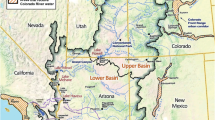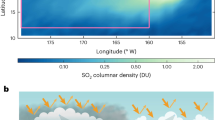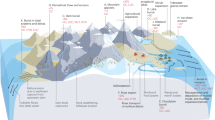Abstract
Polar ice sheets and mountain glaciers, which cover roughly 11% of the Earth's land surface, store organic carbon from local and distant sources and then release it to downstream environments. Climate-driven changes to glacier runoff are expected to be larger than climate impacts on other components of the hydrological cycle, and may represent an important flux of organic carbon. A compilation of published data on dissolved organic carbon from glaciers across five continents reveals that mountain and polar glaciers represent a quantitatively important store of organic carbon. The Antarctic Ice Sheet is the repository of most of the roughly 6 petagrams (Pg) of organic carbon stored in glacier ice, but the annual release of glacier organic carbon is dominated by mountain glaciers in the case of dissolved organic carbon and the Greenland Ice Sheet in the case of particulate organic carbon. Climate change contributes to these fluxes: approximately 13% of the annual flux of glacier dissolved organic carbon is a result of glacier mass loss. These losses are expected to accelerate, leading to a cumulative loss of roughly 15 teragrams (Tg) of glacial dissolved organic carbon by 2050 due to climate change — equivalent to about half of the annual flux of dissolved organic carbon from the Amazon River. Thus, glaciers constitute a key link between terrestrial and aquatic carbon fluxes, and will be of increasing importance in land-to-ocean fluxes of organic carbon in glacierized regions.
This is a preview of subscription content, access via your institution
Access options
Subscribe to this journal
Receive 12 print issues and online access
$259.00 per year
only $21.58 per issue
Buy this article
- Purchase on Springer Link
- Instant access to full article PDF
Prices may be subject to local taxes which are calculated during checkout



Similar content being viewed by others
References
Gardner, A. S. et al. A reconciled estimate of glacier contributions to sea level rise: 2003 to 2009. Science 340, 852–857 (2013).
Radić, V. et al. Regional and global projections of twenty-first century glacier mass changes in response to climate scenarios from global climate models. Clim. Dynam. 42, 37–58 (2013).
Hodson, A. et al. Glacial ecosystems. Ecol. Monogr. 78, 41–67 (2008).
Anesio, A. M. & Laybourn-Parry, J. Glaciers and ice sheets as a biome. Trends Ecol. Evol. 27, 219–225 (2012).
Stibal, M., Šabacká, M. & Žárský, J. Biological processes on glacier and ice sheet surfaces. Nature Geosci. 5, 771–774 (2012).
Hood, E. et al. Glaciers as a source of ancient and labile organic matter to the marine environment. Nature 462, 1044–1047 (2009).
Singer, G. A. et al. Biogeochemically diverse organic matter in Alpine glaciers and its downstream fate. Nature Geosci. 5, 710–714 (2012).
Bhatia, M. P. et al. Organic carbon export from the Greenland ice sheet. Geochim. Cosmochim. Acta 109, 329–344 (2013).
Bhatia, M. P., Das, S. B., Longnecker, K., Charette, M. A. & Kujawinski, E. B. Molecular characterization of dissolved organic matter associated with the Greenland ice sheet. Geochim. Cosmochim. Acta 74, 3768–3784 (2010).
Battin, T. J. et al. Biophysical controls on organic carbon fluxes in fluvial networks. Nature Geosci. 1, 95–100 (2008).
Legrand, M. et al. Major 20th century changes of the content and chemical speciation of organic carbon archived in Alpine ice cores: Implications for the long-term change of organic aerosol over Europe. J. Geophys. Res. Atmos. 118, 3879–3890 (2013).
Legrand, M. et al. Water-soluble organic carbon in snow and ice deposited at Alpine, Greenland, and Antarctic sites: a critical review of available data and their atmospheric relevance. Clim. Past Discuss. 9, 2357–2399 (2013).
Foght, J. et al. Culturable bacteria in subglacial sediments and ice from two Houthern Hemisphere glaciers. Microb. Ecol. 47, 329–340 (2004).
Stibal, M. et al. Methanogenic potential of Arctic and Antarctic subglacial environments with contrasting organic carbon sources. Glob. Change Biol. 18, 3332–3345 (2012).
Telling, J. et al. Controls on the autochthonous production and respiration of organic matter in cryoconite holes on high Arctic glaciers. J. Geophys. Res. 117, G01017 (2012).
Stibal, M. et al. Organic matter content and quality in supraglacial debris across the ablation zone of the Greenland ice sheet. Ann. Glaciol. 51, 1–8 (2010).
Dubnick, A. et al. Characterization of dissolved organic matter (DOM) from glacial environments using total fluorescence spectroscopy and parallel factor analysis. Ann. Glaciol. 51, 111–122 (2010).
Bliss, A., Hock, R. & Cogley, J. G. A new inventory of mountain glaciers and ice caps for the Antarctic periphery. Ann. Glaciol. 54, 191–199 (2013).
Priscu, J. C., Christner, B. C., Foreman, C. M. & Royston-Bishop, G. in Encyclopedia of Quaternary Science (eds Elias, S. & Mock, C.) 1156–1167 (Elsevier, 2007).
Priscu, J. C. & Christner, B. C. in Microbial Diversity and Bioprospecting (ed. Bull, S.) Ch. 13, 130–145 (ASM Press, 2004).
Ping, C-L. et al. High stocks of soil organic carbon in the North American Arctic region. Nature Geosci. 1, 615–619 (2008).
Schuur, E. A. G. et al. Vulnerability of permafrost carbon to climate change: implications for the global carbon cycle. BioScience 58, 701 (2008).
Striegl, R. G., Aiken, G. R., Dornblaser, M. M., Raymond, P. A. & Wickland, K. P. A decrease in discharge-normalized DOC export by the Yukon River during summer through autumn. Geophys. Res. Lett. 32, L21413 (2005).
Bamber, J., van den Broeke, M., Ettema, J., Lenaerts, J. & Rignot, E. Recent large increases in freshwater fluxes from Greenland into the North Atlantic. Geophys. Res. Lett. 39, L19501 (2012).
Bliss, A., Hock, R. & Radić, V. Global response of glacier runoff to twenty-first century climate change. J. Geophys. Res. Earth Surf. 119, 717–730 (2014).
Rignot, E. et al. Recent Antarctic ice mass loss from radar interferometry and regional climate modelling. Nature Geosci. 1, 106–110 (2008).
IPCC Climate Change 2013: The Physical Science Basis (eds Stocker, T. F. et al.) (Cambridge Univ. Press, 2013).
Meier, M. F. et al. Glaciers dominate eustatic sea-level rise in the 21st century. Science 317, 1064–1067 (2007).
Antony, R. et al. Origin and sources of dissolved organic matter in snow on the East Antarctic ice sheet. Environ. Sci. Technol. 48, 6151–6159 (2014).
Hallet, B., Hunter, L. & Bogen, J. Rates of erosion and sediment evacuation by glaciers: A review of field data and their implications. Glob. Planet. Change 12, 213–235 (1996).
Tockner, K., Malard, F., Uehlinger, U. & Ward, J. V. Nutrients and organic matter in a glacial river-floodplain system (Val Roseg, Switzerland). Limnol. Oceanogr. 47, 266–277 (2002).
Dai, M., Yin, Z., Meng, F., Liu, Q. & Cai, W-J. Spatial distribution of riverine DOC inputs to the ocean: an updated global synthesis. Curr. Opin. Environ. Sustain. 4, 170–178 (2012).
Beusen, A. H. W., Dekkers, A. L. M., Bouwman, A. F., Ludwig, W. & Harrison, J. Estimation of global river transport of sediments and associated particulate C, N, and P. Glob. Biogeochem. Cycles 19, GB4S05 (2005).
Bianchi, T. S. The role of terrestrially derived organic carbon in the coastal ocean: A changing paradigm and the priming effect. Proc. Natl Acad. Sci. USA 108, 19473–19481 (2011).
Rignot, E., Velicogna, I., van den Broeke, M. R., Monaghan, A. & Lenaerts, J. T. M. Acceleration of the contribution of the Greenland and Antarctic ice sheets to sea level rise. Geophys. Res. Lett. 38, L05503 (2011).
Gardner, A. S. et al. Sharply increased mass loss from glaciers and ice caps in the Canadian Arctic Archipelago. Nature 473, 357–360 (2011).
Kaser, G., Grosshauser, M. & Marzeion, B. Contribution potential of glaciers to water availability in different climate regimes. Proc. Natl Acad. Sci. USA 107, 20223–20227 (2010).
Moreira-Turcq, P., Seyler, P., Guyot, J. L. & Etcheber, H. Exportation of organic carbon from the Amazon River and its main tributaries. Hydrol. Process. 17, 1329–1344 (2003).
Anesio, A. M., Hodson, A. J., Fritz, A., Psenner, R. & Sattler, B. High microbial activity on glaciers: importance to the global carbon cycle. Glob. Change Biol. 15, 955–960 (2009).
Lavanchy, V. M. H., Gäggeler, H. W., Schotterer, U., Schwikowski, M. & Baltensperger, U. Historical record of carbonaceous particle concentrations from a European high-alpine glacier (Colle Gnifetti, Switzerland). J. Geophys. Res. 104, 21227 (1999).
Stubbins, A. et al. Anthropogenic aerosols as a source of ancient dissolved organic matter in glaciers. Nature Geosci. 5, 198–201 (2012).
Coynel, A., Seyler, P., Etcheber, H., Meybeck, M. & Orange, D. Spatial and seasonal dynamics of total suspended sediment and organic carbon species in the Congo River. Glob. Biogeochem. Cycles 19, GB4019 (2005).
Bardgett, R. D. et al. Heterotrophic microbial communities use ancient carbon following glacial retreat. Biol. Lett. 3, 487–490 (2007).
Hågvar, S. & Ohlson, M. Ancient carbon from a melting glacier gives high 14C age in living pioneer invertebrates. Sci. Rep. 3, 2820 (2013).
Fellman, J. B. et al. The impact of glacier runoff on the biodegradability and biochemical composition of terrigenous dissolved organic matter in near-shore marine ecosystems. Mar. Chem. 121, 112–122 (2010).
Radić, V. & Hock, R. Regional and global volumes of glaciers derived from statistical upscaling of glacier inventory data. J. Geophys. Res. 115, F01010 (2010).
Huybrechts, P. Sea-level changes at the LGM from ice-dynamic reconstructions of the Greenland and Antarctic ice sheets during the glacial cycles. Quat. Sci. Rev. 21, 203–231 (2002).
Pfeffer, W. T., Harper, J. T. & O'Neel, S. Kinematic constraints on glacier contributions to 21st-century sea-level rise. Science 321, 1340–1343 (2008).
Radić, V. & Hock, R. Glaciers in the Earth's hydrological cycle: assessments of glacier mass and runoff changes on global and regional scales. Surv. Geophys. 46, 813–837 (2014).
O'Neel, S., Hood, E., Arendt, A. & Sass, L. Assessing streamflow sensitivity to variations in glacier mass balance. Climatic Change 123, 329–341 (2014).
Acknowledgements
M. Sharp, B. Sattler, A. Dubnick, M. Schwikowski, D. Wagenbach and H. Hoffmann shared unpublished glacier organic carbon data. U. Federer provided TOC data from the Talos Dome ice core. K. Timm produced Fig. 1 and Box 1. M. Gooseff and R. Hood provided photos for Fig. 1. Our work in this area is supported by NSF (OIA-1208927, EAR-0943599) and the DOI Alaska Climate Science Center to E.H. and S.O., FWF START Y420-B17 to T.J.B, and NSF (DEB-1145885/1145932) to E.H., J.B.F., and R.G.M.S.
Author information
Authors and Affiliations
Contributions
E.H., T.J.B., and R.G.M.S. conceived the study. All authors helped with compiling and analysing organic carbon and/or glaciological data and contributed to the writing of the paper.
Corresponding author
Ethics declarations
Competing interests
The authors declare no competing financial interests.
Supplementary information
Supplementary information
Supplementary information (PDF 263 kb)
Rights and permissions
About this article
Cite this article
Hood, E., Battin, T., Fellman, J. et al. Storage and release of organic carbon from glaciers and ice sheets. Nature Geosci 8, 91–96 (2015). https://doi.org/10.1038/ngeo2331
Received:
Accepted:
Published:
Issue Date:
DOI: https://doi.org/10.1038/ngeo2331
This article is cited by
-
Anthropogenic impacts on mud and organic carbon cycling
Nature Geoscience (2024)
-
Global emergent responses of stream microbial metabolism to glacier shrinkage
Nature Geoscience (2024)
-
Predictive mapping of glacial sediment properties (Bellingshausen Dome, King George Island, Antarctica)
Environmental Earth Sciences (2024)
-
A review of physicochemical properties of dissolved organic carbon and its impact over mountain glaciers
Journal of Mountain Science (2024)
-
Marine and Not Terrestrial Resources Support Nearshore Food Webs Across a Gradient of Glacial Watersheds in the Northern Gulf of Alaska
Estuaries and Coasts (2024)



